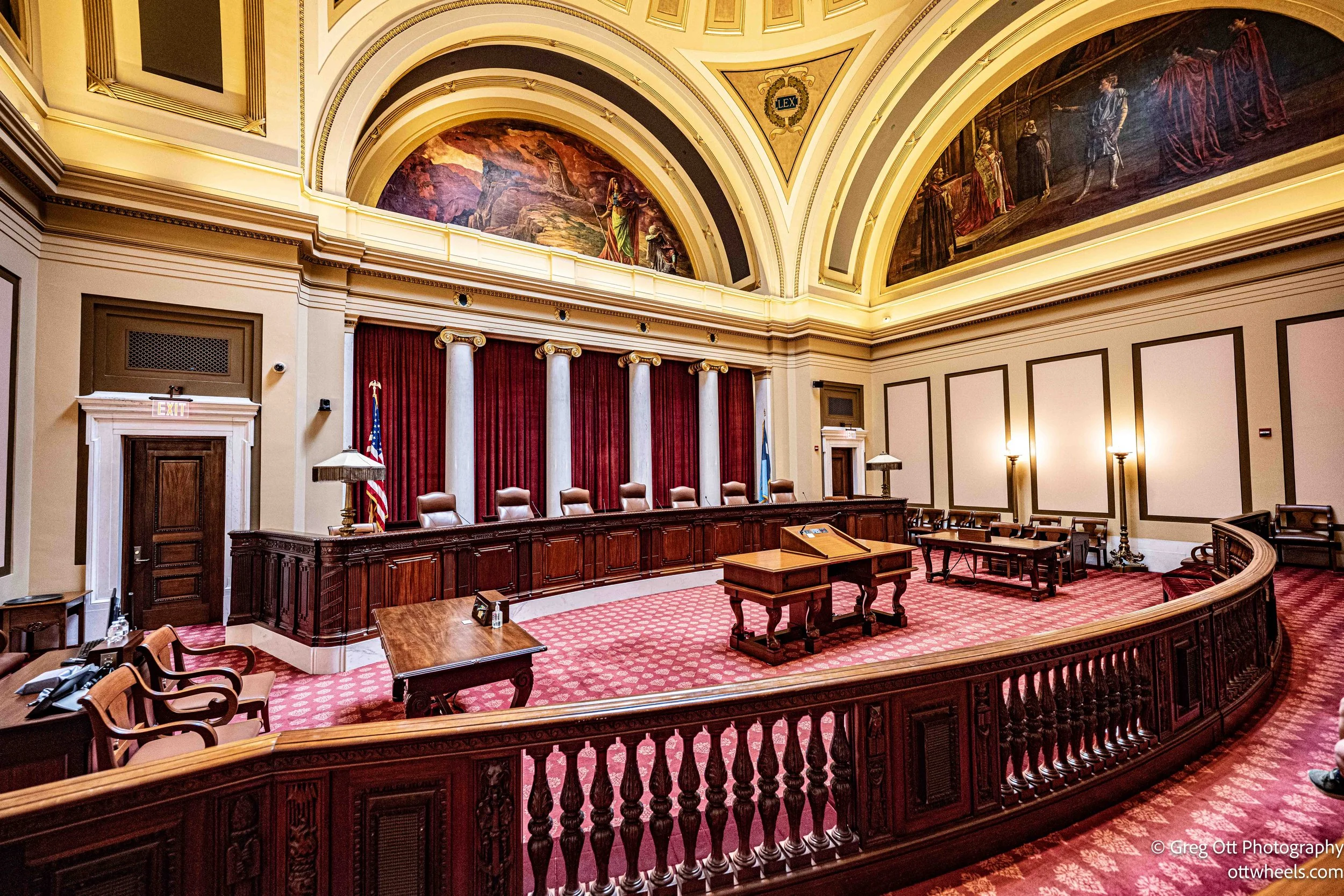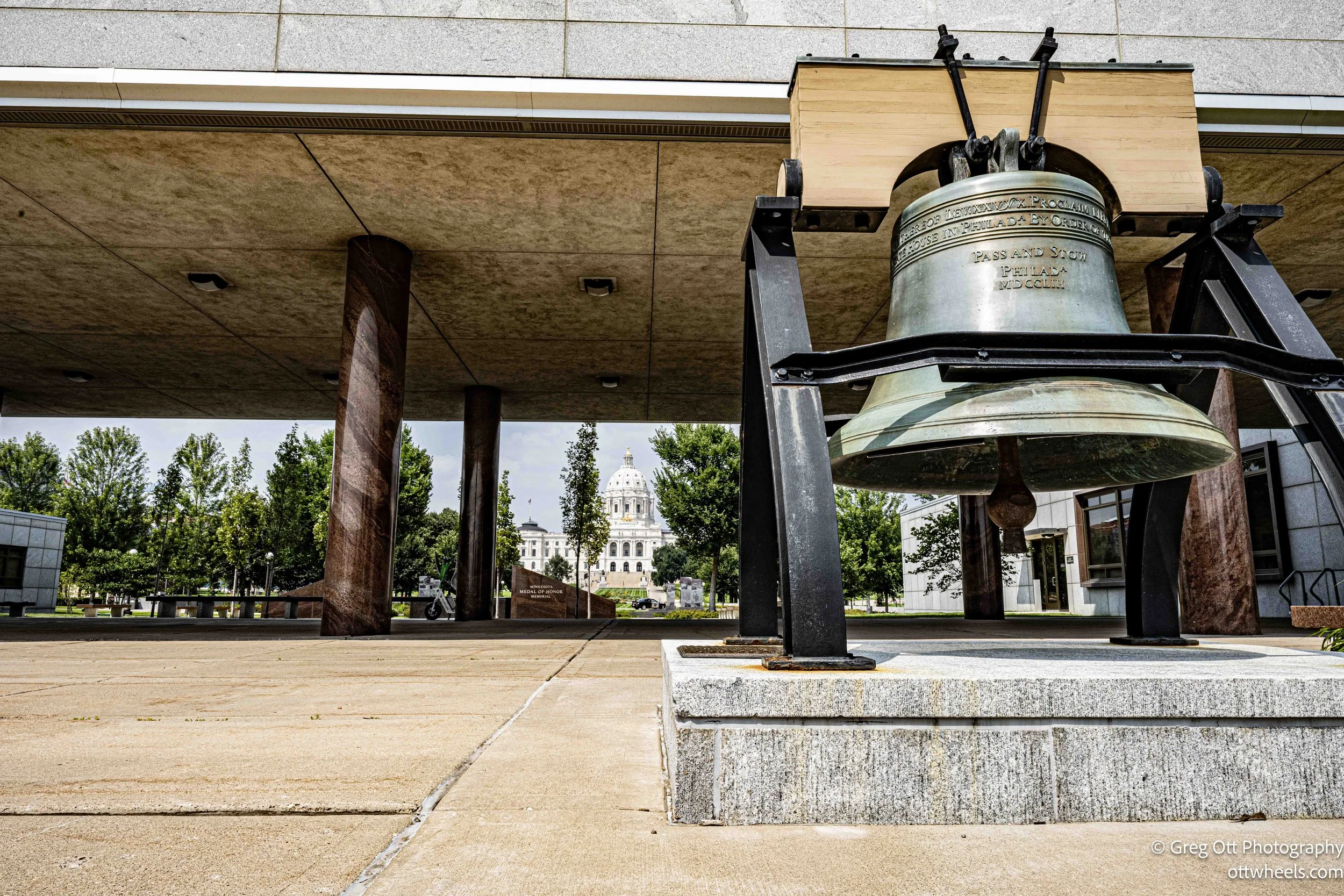Minneapolis, MN - Capitol
I was reading and writing last night in the parking lot of the St. Croix National Scenic Riverway Visitor Center, and it was late. There was a Walmart a few miles away, and I had stayed there the previous night. It wasn’t real loud, but it was very quiet here. There were “no overnight parking” signs, and my van seemed to blend in with the government vehicles that were parked there. So, I decided to just stay the night.
I spent a couple hours looking at the map of Minnesota and starting to plan my trip through the state. The points of interest made a big loop around the state, with North Dakota up next. Due to the north–south length of Minnesota, it made sense to drop down to Minneapolis, the capital, and then swing back north to start the loop.
I was on my way around 10:45 to Minneapolis, the capital of Minnesota (MN). I was saying goodbye to the Badger State, completing another state—number 26. The trip took about 90 minutes on back roads, driving slower than the speed limit. I arrived in the capital around noon and searched for parking near the Capitol. It was Saturday and the streets were busy, but around the Capitol things seemed much calmer. People were strolling and walking the grounds. Not all the parking kiosks were functioning, but I noticed a couple down the street inserting a credit card—a clue the device was working. It was pay-by-license plate, and a couple dollars covered a few hours.
Capitol Tour
I knew tours ran every hour on the hour from 10 to 2, so I stopped at the information desk inside the Capitol to confirm the times. With a few minutes to spare before the next tour, I stepped back outside to grab some photos of the building. Front and center above the entrance is a stunning gold-covered sculpture that immediately reminded me of the Brandenburg Gate in Berlin. It’s a four-horse chariot—called a quadriga—driven by a female figure symbolizing Minnesota, flanked by two men representing agriculture and industry.
Officially titled Progress of the State, the sculpture draws from classical Roman design, much like Berlin’s famous gate, but reimagines it with a distinctly American twist. The four gilded horses represent the elemental forces of nature: earth, air, fire, and water. Rather than glorifying conquest, the piece speaks to Minnesota’s spirit of progress, strength, and balance with nature. It’s a bold, symbolic crown for an already impressive building—and a reminder that even in politics, art knows how to make an entrance.
I hopped on the 1 p.m. tour of the Minnesota State Capitol, which runs every hour on the hour from 10 to 2. It’s free, which is always a plus, but only 45 minutes long—just enough time to make you feel like you’re being shuffled through a museum with rocket shoes. Our first stop was the Minnesota Supreme Court chamber, a stately, echoey space where our guide jumped right in. The mural behind the bench, painted by John LaFarge, is called The Contemplation of Justice. It features Justice herself (blindfolded, of course), flanked by figures representing punishment and mercy. It’s the kind of painting that whispers, “behave yourself.” We learned that Minnesota’s seven Supreme Court justices are elected—unlike the federal level—and serve six-year terms. Between the painting, the stately woodwork, and the weight of the room, you could practically hear the gavel drop.
From there, we were herded up to the Senate gallery. No, we didn’t get to walk on the plush carpeting or sit in the fancy chairs—just the gallery seats above it—but the view still packed a punch. The murals in this room were painted by Edwin Blashfield, with themes like civic virtue, law, and wisdom. Our guide shared a fun little secret: a few senators had their faces subtly included in the paintings to help “encourage” the legislature to approve payments to the architect and the artists. Apparently, flattery pays. She also reminded us—proudly—that Minnesota has the largest Senate body relative to its population, with 67 senators. They typically serve four-year terms, except right after redistricting, when they get a two-year reset. As we left the chamber and walked back out into the hallway, the guide stopped and looked down. “See the floor?” she said. “These tiles were a surprise.” During the massive renovation a few years ago, workers pulled up old carpeting and discovered a stunning mosaic tile floor that had been hidden for decades. You could practically hear the Capitol itself sigh in relief.
Then came the highlight: the roof. We climbed a narrow staircase (which felt more like a medieval tower than a government building) to get face-to-face with the Capitol’s most iconic sculpture—Progress of the State. I’d admired it from the ground earlier, but nothing compares to standing a few feet from four gold-leaf horses gleaming in the sunlight. The whole thing weighs over 8,000 pounds and was recently restored along with the building. Designed by Daniel Chester French—the same sculptor behind the Lincoln Memorial—and executed by Edward Clark Potter, the quadriga is packed with symbolism. The woman in the chariot represents Minnesota, confidently guiding the four elemental forces: earth, air, fire, and water. The two men beside her stand in for agriculture and industry, the foundations of the state’s economy in 1905. The whole thing screams classical ambition with a Midwestern twist, like the Brandenburg Gate with a work ethic and a strong jawline.
We wrapped things up in the rotunda beneath the Capitol’s massive marble dome, which holds the bragging rights of being the third-largest unsupported dome in the world—trailing only St. Peter’s in Rome and the Taj Mahal. “Unsupported,” in case you’re wondering, means it holds itself up with no interior supports—no metal beams, no wooden struts. Just beautifully balanced stone. Architect Cass Gilbert, who also designed the U.S. Supreme Court building, was the mind behind all of this. He sourced marble from Georgia and Italy, limestone from Minnesota, and wrapped it all up in a neoclassical bow. The current building is actually Minnesota’s third capitol—the previous one went up in flames, and before that, they were basically playing government in a large house. This one, though, feels permanent. Every room, hallway, dome, and stairwell carries a sense of purpose—and, apparently, a record-breaking statistic. Highest, heaviest, tallest, biggest... Minnesota doesn’t do modesty when it comes to its Capitol. And after this tour, I kind of respect that.
Near the end of the tour, I asked the guide where Minnesota’s Liberty Bell was located—one of the 53 replicas gifted by the French in 1950. She told me Minnesota didn’t get one. I was pretty sure that wasn’t right, but I didn’t push it. After the tour, I stopped by the information center and asked the woman at the desk. Without hesitation, she stood up, pointed down the mall, and said, “It’s at the Veterans Memorial.” I thanked her and stepped back outside, where I ran into a couple I’d chatted with during the tour—fellow travelers. They were trying to take a selfie, so I offered to snap a photo for them, and they returned the favor. Then I made my way down the mall, taking in the broad, tree-lined path and stopping for a few more photos. The lawn was cut high with a triangular pattern—the kind of perfect landscaping that makes you appreciate government buildings at their best.
Minneapolis Sculpture Garden
As I walked to the Sculpture Garden, I stumbled upon something unexpected—an amateur baseball game in full swing. Two local teams, dressed in sharp uniforms, were battling it out on a well-kept field while about a hundred people watched from the stands. I hung around for a few minutes. I read later that Minnesota has a deep-rooted tradition of “town ball”—amateur baseball teams made up of local players who compete in regional leagues just for the love of the game. These aren’t pros, but they play hard, and the crowd—likely friends, family, and proud neighbors—was all in. It’s grassroots baseball at its finest.
A couple was coming into the game carrying ice cream with all the toppings. She told me it’s from the food truck over there and pointed. He said, “That’s not a truck, that’s a bus.” She playfully whacked him on the arm and said, “OK, the blue bus.” I thanked them and headed in that direction. There was a line, but it was moving quickly. It was actually frozen yogurt, and I ordered a combination of pineapple and chocolate with Oreos and fresh-cut strawberries. I’m not sure why, but yogurt is always more expensive than ice cream.
I found a seat near the fountain with a big cherry and spoon. I was full-in on relaxing and people-watching. I was struck by the ethnic diversity of the city—it was nice hearing so many languages. Many people had come to get their photos taken in front of the sculpture.
I stopped to take pictures of the sculpture myself. There was a reporting team interviewing someone, and the reporter—Richard Reeve from ABC Minneapolis—started chatting with me. He was originally from near NYC, close to Connecticut. He was getting opinions about the fires and air quality. I told him that I had noticed the poor air for the past month and that at times I found myself coughing. Apparently, there was an air quality alert. He interviewed me on camera, thanked me, and wished me fun travels.
Walker Art Center
I finished the Sculpture Garden and walked over to the Walker Art Center. Entrance was free on the first Saturday of the month. I only had about 45 minutes before they closed at 5. I went to the roof to get a view of the city.
I noticed the plaque first—Three x Four x Three, by Sol LeWitt. I hadn’t realized he did sculpture, but the abstract, grid-like form made perfect sense once I saw his name. I remembered an exhibition of his at the New Britain Museum of American Art back in 2022—highly analytical work, more about structure and process than personal expression. LeWitt was known for giving precise written instructions to students or assistants, then stepping back to see how closely the result matched his vision. Seeing this piece in three dimensions felt like one of those instructions brought to life.
I stopped at a shiny, reflective cube with holes cut into the sides—like a three-dimensional kaleidoscope. I had my camera right up to one of the openings when a security guard (turned out he was an art student) started walking over. I figured I was about to get scolded for getting too close. Instead, he leaned in and said, “Can I see the image you got?” I showed him, and he lit up: “That’s amazing. Try putting the lens in the hole—just don’t touch it.” Totally not what I expected, but I was all in. We both looked at the result and just stood there, surprised. He gave me a thumbs up, and I moved on.
I had just made it to the next floor when I heard a voice call out, “Ten minutes until closing.” That kicked me into high gear. I sped up my pace, only pausing at pieces that really pulled me in. As I rushed through, I couldn’t help but think—I should’ve started with the Art Center.
I made the rounds of the Sculpture Garden again, watching people taking photos of themselves with various sculptures, flowers, and friends.
I walked back to the van as the parking lot slowly emptied out. With a bit of quiet settling in, I took the time to finish planning my 14-day trip around Minnesota. In the far corner of the lot, one of those local town ball teams had set up a barbecue for their players. A couple of cars pulled in nearby, and more teammates trickled in to join them.
I stayed until the sun began to set, soaking in the view before hitting the road. I had found a spot to park along Lake Superior, just north of Duluth, and made myself an espresso to stay sharp for the 2½-hour drive ahead. The sunset was unreal—smoke in the air turned the sun into a glowing orange ball, with horizontal streaks of fiery color cutting through the sky. The haze in the distance faded into soft hues of pale orange and blue along the horizon.
I pulled into a parking lot with a dim light at one end. There were 20 spots, meant for accessing the rocky beaches of Lake Superior, 50 feet behind me. It was relatively quiet, the main road being a mile away.































